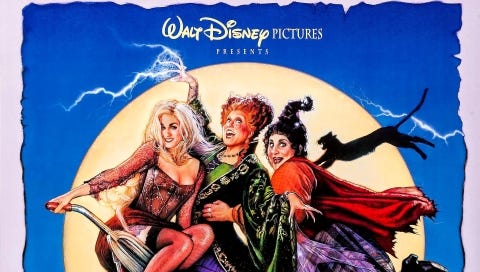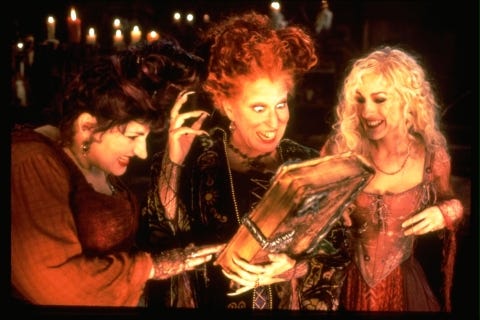By 1993, Bette Midler was nearing the end of her association with Disney. Her time at the studio was well spent. She’d enjoyed numerous critical and commercial successes, made a stunning return to the pop charts and won a couple of Grammys for a song from a Touchstone film we’ll be getting to very soon. But her contract was about up and she was beginning to look elsewhere. She’d already turned down the lead in one Touchstone picture, Sister Act, and taken another project, For The Boys, over to 20th Century Fox (which, of course, means it ended up being a Disney movie anyway…sigh). But there was one movie left at Disney she really wanted to do. And, while it might not have seemed like it at the time, it ended up being one of the defining movies of the Divine Miss M’s career.
Hocus Pocus was actually written back in the ‘80s, probably right around the same time Midler was first signing her Disney contract. The movie was conceived by David Kirschner, who came up with the Sanderson Sisters and their associated lore as a story for his young daughters. Kirschner began his career as an illustrator working for Jim Henson before coming up with the idea for An American Tail. He pitched it to Jeffrey Katzenberg, who rejected it, reportedly unable to fathom why anyone would want to see a movie about a Jewish mouse. But then he got the opportunity to pitch Steven Spielberg, who said yes immediately. Directed by Disney defector Don Bluth, An American Tail was a massive success and represented the first substantial threat to Disney’s feature animation dominance.
After Spielberg and Bluth picked up the ball Katzenberg fumbled, the Disney exec gave Kirschner a call asking for more ideas. Kirschner put together an elaborate pitch for Hocus Pocus, playing up the fact that Halloween was a billion-dollar cottage industry that had been inexplicably ignored by the family film market. Katzenberg may or may not have responded to anything else in Kirschner’s presentation but he sure heard that part. Disney agreed to buy Hocus Pocus before Kirschner even left the building.
To work on the screenplay, Kirschner contacted another Spielberg associate, future Master of Horror Mick Garris. Garris had worked as a journalist, critic and behind-the-scenes documentarian before landing a plum job as story editor on Spielberg’s TV series, Amazing Stories. At one point, Garris and Kirschner approached Spielberg about potentially co-producing Hocus Pocus with Disney. But Spielberg was at the height of setting up his own Disney-esque empire at Amblin and didn’t feel like helping the competition.
Things might have been easier if Spielberg had agreed to give the project a push. As it is, Hocus Pocus languished in development hell at Disney for years as the studio assigned the project to a revolving door of writers. In the meantime, David Kirschner kept busy with a myriad of other projects, including producing and designing Chucky for Child’s Play. Mick Garris, who’d taken one of his rejected Amazing Stories over to Disney and made the TV-movie Fuzzbucket, branched into feature directing with Critters 2 and began a lengthy and fruitful collaboration with Stephen King on Sleepwalkers.
As the years passed, plenty of writers took a swing at Hocus Pocus but only one made enough of a contribution to receive a credit. Neil Cuthbert had a background in playwriting and television. In 1985, he’d developed the short-lived Showtime sitcom Washingtoon, based on Mark Alan Stamaty’s comic strip. Like a lot of Hollywood writers, he’d worked on more unproduced projects than produced, including a version of A Connecticut Yankee In King Arthur’s Court for Robin Williams. Cuthbert would later go on to write Mystery Men, based on the great Bob Burden comic, and Eddie Murphy’s The Adventures Of Pluto Nash, but we’ll try not to hold that last one against him.
Hocus Pocus might still be collecting dust in the Disney archives if Bette Midler hadn’t taken an interest in it. The studio obviously wasn’t in any hurry to rush the project into production. But Midler liked the script and wanted to play Winifred Sanderson. Everything else fell into place fairly quickly after that. Kenny Ortega was lined up to direct, which probably helped keep his mind off the scathing response to his previous film, Newsies. Sarah Jessica Parker, who had come a long way since her last Disney appearance in Flight Of The Navigator, was cast as flighty Sarah Sanderson. And after Rosie O’Donnell turned down the part of Mary Sanderson, the part went to Kathy Najimy, who’d just become one of the breakout scene-stealers of Sister Act.
A lot of the eight or nine years spent developing the script was spent fine-tuning the young protagonists who inadvertently summon, then try to stop the Sanderson Sisters. The role of Max Dennison, the L.A. transplant whose snarky disbelief in magic triggers everything, was first offered to Leonardo DiCaprio. When he passed on it to make What’s Eating Gilbert Grape, it went to Omri Katz, who had appeared in Joe Dante’s TV series Eerie, Indiana and movie Matinee. Young Thora Birch, who’d already appeared in Touchstone’s Paradise alongside Huck Finn star Elijah Wood, was cast as Max’s sister, Dani. Rounding out the ensemble was Vinessa Shaw as Allison Watts, Max’s classmate and crush.
As written, the kids are really nothing special. We’ve seen plenty of movies with the cool kid forced against his will to move across country to a small but charming and picturesque town, the wise-and-resourceful-beyond-their-years little sibling and the popular, aloof golden girl who slowly warms up to our underdog hero. In other hands, the characters would be nondescript and forgettable (or worse, actively irritating). But Katz, Birch and Shaw (sounds like a law firm) are so charming and likable that the characters come to life a little bit more. They may not be fully three-dimensional but they’re at least two-and-a-half.
Of course, the main thing people remember about Hocus Pocus is the over-the-top performances of the Sanderson Sisters themselves. Bette Midler has said repeatedly that Winifred was her favorite role and the most fun she ever made making a movie. That is readily apparent. All three women look like they’re having a grand old time chewing the scenery. They’re all fun but the movie’s secret weapon is Sarah Jessica Parker, who really seems to be relishing the opportunity to cut loose. Even when she isn’t the focal point of the scene, you want to keep your eye on her to catch all her little random bits of business.
Kenny Ortega strikes exactly the right tone, keeping things light enough for the whole family but never losing sight of the macabre. Two of the movie’s most beloved characters are victims of the Sandersons. Thackeray Binx (played in human form by Sean Murray and voiced by Jason Marsden) was transformed into an immortal black cat after trying and failing to save his sister from the witches. Billy Butcherson (an early heavy-makeup role for the great Doug Jones) was killed by Winifred before they were to be married and is resurrected as a zombie. There’s dark material to be mined from both of these characters but Ortega is smart enough to leave them relatively untapped, including just enough to make them feel real.
In many ways, Hocus Pocus feels like a modernized version of classic Disney fantasy-comedies like Blackbeard’s Ghost. It’s all very silly and random and spooky without being remotely scary. Although there is a ticking-clock element to the story (the Sandersons are only back for one night, after all), nobody ever seems all that concerned about their impending deadline. The sisters can always make time to perform at the local Halloween dance or stop by for an extended visit with “Master Devil” (Garry Marshall) and “Medusa Lady” (his sister, Penny Marshall, both appearing uncredited). Theoretically, these tangents should work against the movie. Instead, they add to it and help give the picture its own unique rhythm. A rhythm that, unfortunately, very few people responded to at the time.
For some inexplicable reason, Disney opened Hocus Pocus, a movie specifically designed to capitalize on Halloween, on July 16, 1993. Perhaps they didn’t want to cannibalize the potential audience for the other ambitious Halloween-themed movie they planned to open later in the year, which ended up being shuttled over to Touchstone anyway (you can probably guess which one and we’ll get there eventually). Whatever the rationale, this pitted the Sanderson Sisters against more traditional summer movie fare as Jurassic Park, The Firm and In The Line Of Fire. Hocus Pocus debuted behind all of those despite the fact that they’d all been around a while at that point.
Worse yet, most critics absolutely hated the movie. Siskel and Ebert wound up putting it on their lists of the worst films of 1993 (which, come on guys…really? I don’t love it but it’s not that bad). The movie wasn’t exactly a flop for the ages. It ended up earning about $39 million, which was more than its budget but certainly nothing to write home about. But the financial disappointment coupled with its disastrous critical reputation gave the movie a reputation as an utter disaster.
But as we’ve seen several times in this column, death on your initial release doesn’t necessarily mean eternal damnation and the Sandersons have proven extremely difficult to kill. Several years after Hocus Pocus was supposed to have been forgotten about, the Disney Channel decided to air it for Halloween (a radical idea, I know). Surprised by how high the ratings were, they stuck it back on the air a few more times. Each time, the viewership increased. While no one was paying attention, Hocus Pocus had quietly become a cult hit.
This is nothing new, of course. There are countless examples of movies being rescued from obscurity by home video and cable. We’ve seen plenty right here. But Hocus Pocus just wouldn’t stop getting bigger. The Disney-owned Freeform programmed a 24-hour Hocus Pocus marathon, playing it around the clock on Halloween. A 20th Anniversary screening drew legions of fans, followed by a 25th reunion special that was even bigger. Bette Midler has certainly done her share to keep the Black Flame Candle burning. She’s hosted charity events and appeared in concert as Winifred.
These days, Hocus Pocus is inescapable the moment the calendar turns to October. There are books, costumes, Funko Pops and merch galore everywhere you turn. In response to its new popularity, Disney finally produced a sequel which aired on Disney+ in 2022. We may or may not get to that in this column. Honestly, I haven’t quite decided what to do with Disney+ movies yet.
It feels a little strange to refer to Hocus Pocus as a cult movie, even though that’s exactly what it is. In many ways, it’s become A Christmas Story for Halloween, cinematic comfort food that millions of fans know inside and out. That’s quite a transformation for a movie that struggled for years to even get made, then seemed destined to be forgotten as a ridiculous failure. The Sanderson Sisters have endured and will no doubt continue to attract new acolytes for as long as Disney can beam content into living rooms.
VERDICT: Disney Plus







I haven’t actually seen this entire movie. And I’m not sure that I ever will, but I have to respect the fact that it has turned out to be so successful.